2013年08月31日
Art on Ibukijima
I had the good fortune to visit Ibukijima before the start of the summer session of the Setouchi Triennale 2013. I went to observe a workshop by Mikan-gumi and the Sogabe Lab (Kanagawa University).

View from Mikan/Sogabe Lab site
This team of architects and students, led by Masashi Sogabe, has been involved in various experimental architectural projects for the reconstruction of communities devastated by the 2011 tsunami in northeastern Japan. They are applying this experience to the project on Ibukijima, a community that is being rapidly eroded by depopulation and aging. The project is temporarily housed in the unused fish processing plant in the photo below.
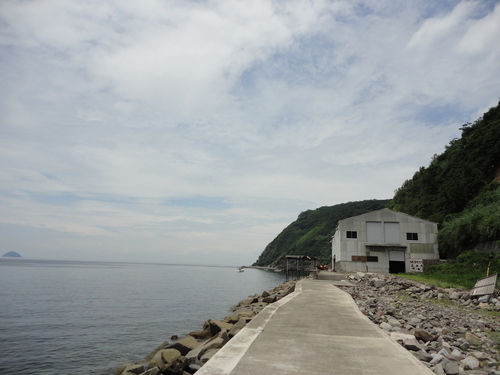
The team’s first step was to walk the entire island and then reproduce it as a model.

Every household was visited and invited to take part in the next step, the collection of memories. At the workshop, islanders shared memories of places that have disappeared,
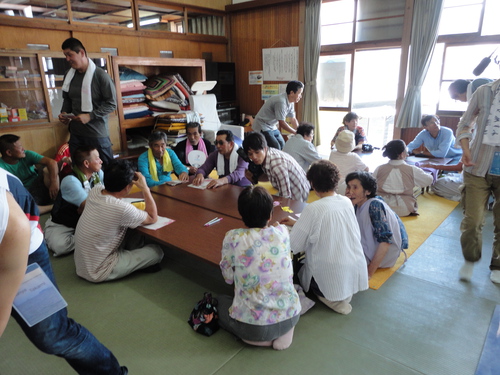
writing the names of these places on flags
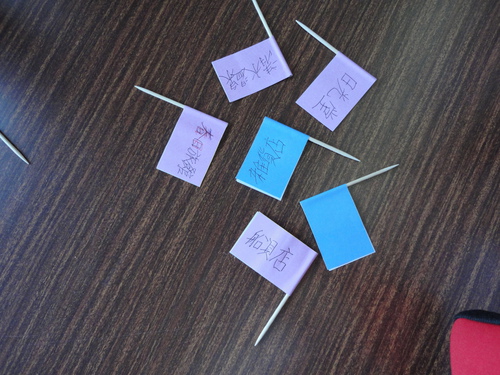
and sticking them in the island.
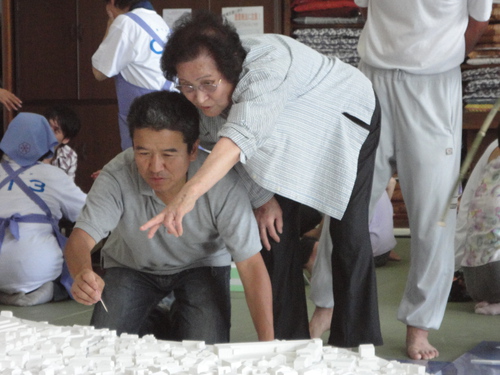
This model was then displayed at the art site, surrounded by blackboards on which further information was added as islanders shared new information.
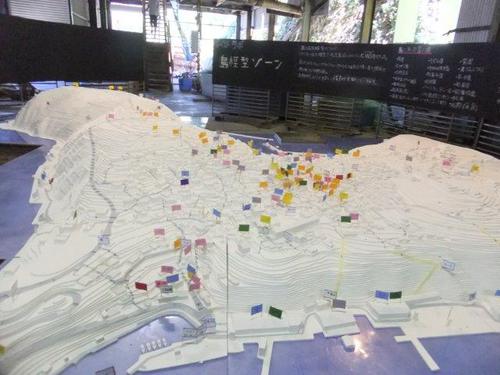
According to Sogabe, the collection of memories is just the preparatory stage. During this process, key people on the island are being identified and encouraged to keep the project moving. The team will continue to visit every 6 months or so as the islanders move on to the next phase of consulting on the island’s future and deciding what they want to save and what they want to let go.
The art site itself also utilized many mementos from the past to furnish the gallery and café.
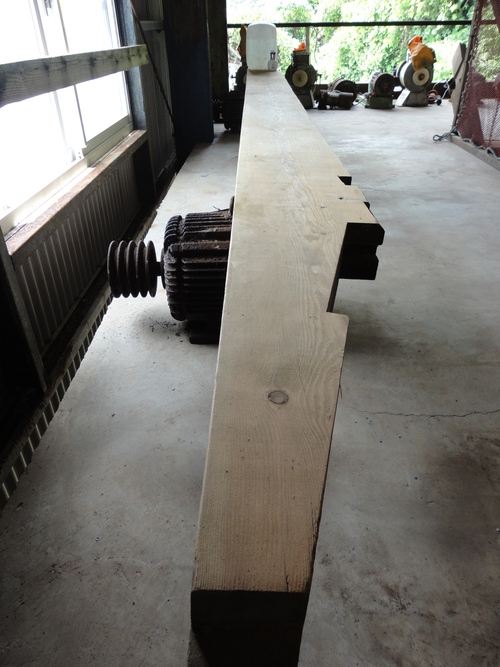

Other Triennale art sites included “Rainbow Hut” at the top of the island. I came across the artist, Tsuneo Sekiguchi, while his project was still in progress.

While making this work, Sekiguchi worked part time on the Ibukijima fishing boats to support himself but also to get to know the islanders. The hut is made of old blankets collected from the village and coated with adobe. Inside, pools of water with prisms catch the light and reflect it on the walls. Unfortunately, I missed seeing these but the very organic looking exterior was still worth the climb up the hill.


Further down the hill is “A Murmur of Small Island” by Taebeom Kim, set in the playground of a defunct nursery school. Kim
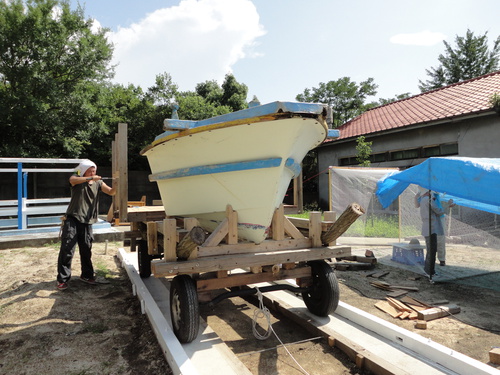
assisted by a team of volunteers,
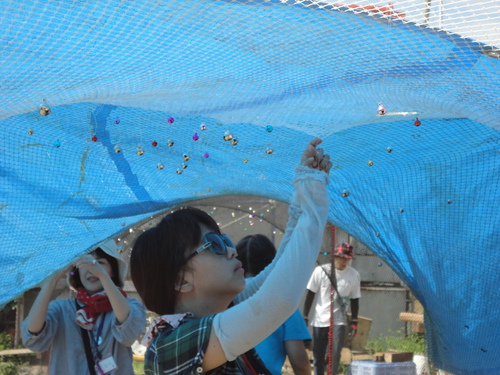
used an old boat and discarded playground equipment to create the fantasy land below.

“Unsinkable Ship” by Ryo Toyofuku & Chiba Art School presented another fantasyland, featuring 50,000 colorful floats made by islanders and Kanonji residents. These were strung through a school building to resemble schools of fish swimming through the sea.


There were more art sites but I am out of space. Let me conclude with “Oiwa Island 2” by Oscar Oiwa. For those who loved Oiwa Island on Ogijima, which burned down in 2010, this work certainly does not disappoint. This time Oscar used his marker magic to create a Setouchi panorama within a huge inflatable dome.
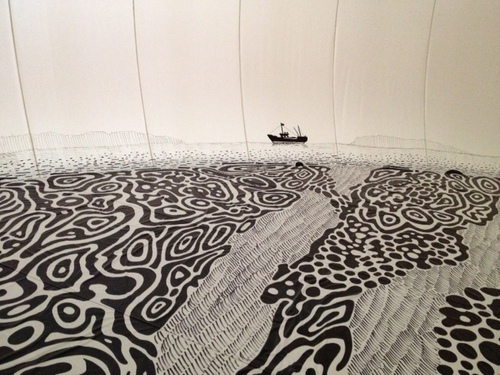
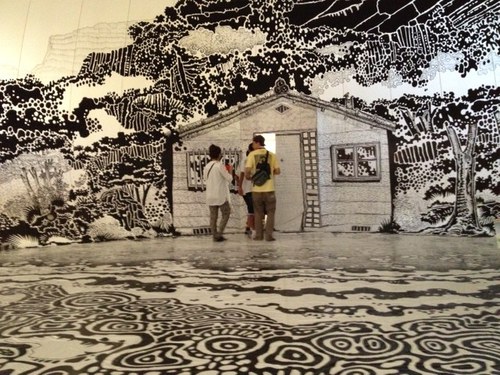
But Oscar really "says" it all and much better in this video of the project in the making:
http://www.youtube.com/watch?v=v99e3Wvp4qE
Although the Triennale on Ibukijima has ended, there is still the Triennale autumn session (Oct. 5 to Nov. 4) with 3 additional islands to look forward to. And, of course, the art sites on many islands will remain open even during the off-season (regular admission fees required). For more info, see: http://setouchi-artfest.jp/
Takamatsu Access:
Takamatsu makes a great base for visiting the Triennale. There are direct flights from Tokyo’s Haneda Airport, as well as from Taiwan, China and Korea, and an express bus link from Kansai International Airport (3 hr). It can also be reached by taking the bullet train to Okayama and changing to the Marine Liner bound for Takamatsu (runs every 1/2 hour; takes 1 hour). For more info see http://wikitravel.org/en/Takamatsu
Many thanks to K. Iwabuchi for helping with this article.

View from Mikan/Sogabe Lab site
This team of architects and students, led by Masashi Sogabe, has been involved in various experimental architectural projects for the reconstruction of communities devastated by the 2011 tsunami in northeastern Japan. They are applying this experience to the project on Ibukijima, a community that is being rapidly eroded by depopulation and aging. The project is temporarily housed in the unused fish processing plant in the photo below.

The team’s first step was to walk the entire island and then reproduce it as a model.

Every household was visited and invited to take part in the next step, the collection of memories. At the workshop, islanders shared memories of places that have disappeared,

writing the names of these places on flags

and sticking them in the island.

This model was then displayed at the art site, surrounded by blackboards on which further information was added as islanders shared new information.

According to Sogabe, the collection of memories is just the preparatory stage. During this process, key people on the island are being identified and encouraged to keep the project moving. The team will continue to visit every 6 months or so as the islanders move on to the next phase of consulting on the island’s future and deciding what they want to save and what they want to let go.
The art site itself also utilized many mementos from the past to furnish the gallery and café.


Other Triennale art sites included “Rainbow Hut” at the top of the island. I came across the artist, Tsuneo Sekiguchi, while his project was still in progress.

While making this work, Sekiguchi worked part time on the Ibukijima fishing boats to support himself but also to get to know the islanders. The hut is made of old blankets collected from the village and coated with adobe. Inside, pools of water with prisms catch the light and reflect it on the walls. Unfortunately, I missed seeing these but the very organic looking exterior was still worth the climb up the hill.


Further down the hill is “A Murmur of Small Island” by Taebeom Kim, set in the playground of a defunct nursery school. Kim

assisted by a team of volunteers,

used an old boat and discarded playground equipment to create the fantasy land below.

“Unsinkable Ship” by Ryo Toyofuku & Chiba Art School presented another fantasyland, featuring 50,000 colorful floats made by islanders and Kanonji residents. These were strung through a school building to resemble schools of fish swimming through the sea.


There were more art sites but I am out of space. Let me conclude with “Oiwa Island 2” by Oscar Oiwa. For those who loved Oiwa Island on Ogijima, which burned down in 2010, this work certainly does not disappoint. This time Oscar used his marker magic to create a Setouchi panorama within a huge inflatable dome.


But Oscar really "says" it all and much better in this video of the project in the making:
http://www.youtube.com/watch?v=v99e3Wvp4qE
Although the Triennale on Ibukijima has ended, there is still the Triennale autumn session (Oct. 5 to Nov. 4) with 3 additional islands to look forward to. And, of course, the art sites on many islands will remain open even during the off-season (regular admission fees required). For more info, see: http://setouchi-artfest.jp/
Takamatsu Access:
Takamatsu makes a great base for visiting the Triennale. There are direct flights from Tokyo’s Haneda Airport, as well as from Taiwan, China and Korea, and an express bus link from Kansai International Airport (3 hr). It can also be reached by taking the bullet train to Okayama and changing to the Marine Liner bound for Takamatsu (runs every 1/2 hour; takes 1 hour). For more info see http://wikitravel.org/en/Takamatsu
Many thanks to K. Iwabuchi for helping with this article.
My Profile
Cathy Hirano キャシー ヒラノ
I've lived in Japan since 1978. After graduating from a Japanese university with a BA in cultural anthropology in 1983, I worked as a translator in a Japanese consulting engineering firm in Tokyo for several years. My Japanese husband and I moved to Takamatsu in 1987 to raise our two children in a slower-paced environment away from the big city pressures. We've never regretted it. I work as a freelance translator and interpreter and am involved in a lot of community work, including volunteering for Second Hand, a local NGO that supports educational and vocational training initiatives in Cambodia, and for the Takamatsu International Association. I love living in Takamatsu.
Cathy Hirano キャシー ヒラノ
I've lived in Japan since 1978. After graduating from a Japanese university with a BA in cultural anthropology in 1983, I worked as a translator in a Japanese consulting engineering firm in Tokyo for several years. My Japanese husband and I moved to Takamatsu in 1987 to raise our two children in a slower-paced environment away from the big city pressures. We've never regretted it. I work as a freelance translator and interpreter and am involved in a lot of community work, including volunteering for Second Hand, a local NGO that supports educational and vocational training initiatives in Cambodia, and for the Takamatsu International Association. I love living in Takamatsu.
Posted by cathy at 21:40│Comments(2)
この記事へのコメント
こんにちは。キャシーさん。
この記事を読んで、あの熱い(暑いじゃないですよ!)夏を思い出し、そしてその夏も終わったんだなと、少しせつなくなりました。
みかんぐみの建物も先日の長雨で崖が崩れ、今は近寄る事が出来ないと聞いております。
厳しい環境の中、人情味あふれる島の暮らしを、瀬戸芸秋会期の島でも紹介していただけたらと思います。
また秋の島でもお会いできます事を。
この記事を読んで、あの熱い(暑いじゃないですよ!)夏を思い出し、そしてその夏も終わったんだなと、少しせつなくなりました。
みかんぐみの建物も先日の長雨で崖が崩れ、今は近寄る事が出来ないと聞いております。
厳しい環境の中、人情味あふれる島の暮らしを、瀬戸芸秋会期の島でも紹介していただけたらと思います。
また秋の島でもお会いできます事を。
Posted by みき@こえび隊員 at 2013年09月11日 12:44
みきさん、コメントをありがとうございました!伊吹島を何回もまわり、あの崖を降りたり、登ったりして作品作りに挑んだみかんぐみもすごいなと思っていましたが、崖がくずれて残念です。島民との交流を続けながらのプロジェクトなので、今度はよりやりやすく、安定した場所を見つけるといいですね。
しかし、瀬戸内の島々は本当に魅力にあふれるところばかりで、秋会期もとても楽しみにしています。今度みきさんとはどこの島で出会えるのかも楽しみです。
しかし、瀬戸内の島々は本当に魅力にあふれるところばかりで、秋会期もとても楽しみにしています。今度みきさんとはどこの島で出会えるのかも楽しみです。
Posted by cathy at 2013年09月11日 22:47
at 2013年09月11日 22:47
 at 2013年09月11日 22:47
at 2013年09月11日 22:47※会員のみコメントを受け付けております、ログインが必要です。





